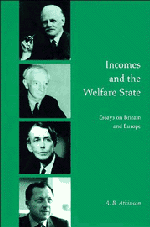Book contents
- Frontmatter
- Contents
- List of figures
- List of tables
- Preface
- Introduction
- I Income inequality and poverty in Britain and Europe
- II Analysis of the Welfare State
- III Targeting and the future of social security policy
- 12 On targeting and family benefits
- 13 The Western experience with social safety nets
- 14 Towards a European social safety net?
- 15 Beveridge, the national minimum and its future in a European context
- 16 State pensions for today and tomorrow
- Notes
- Bibliography
- Name index
- Subject index
12 - On targeting and family benefits
Published online by Cambridge University Press: 03 May 2011
- Frontmatter
- Contents
- List of figures
- List of tables
- Preface
- Introduction
- I Income inequality and poverty in Britain and Europe
- II Analysis of the Welfare State
- III Targeting and the future of social security policy
- 12 On targeting and family benefits
- 13 The Western experience with social safety nets
- 14 Towards a European social safety net?
- 15 Beveridge, the national minimum and its future in a European context
- 16 State pensions for today and tomorrow
- Notes
- Bibliography
- Name index
- Subject index
Summary
Targeting is an attractive idea. The concentration of benefits on those in need is an objective which commands wide support. According to the Green Paper outlining the approach of the United Kingdom government to social security reform, ‘the Government believe that resources must be directed more effectively to the areas of greatest need We must target the resources we have more effectively’ (Department of Health and Social Security, 1985, p. 18). In policy terms, this is taken to mean a shift towards income-related transfers and away from universal benefits paid without a test of means.
For policy makers, there is much appeal in the idea that the existing total of transfers can be reallocated to increase their effectiveness in combating poverty. And simple arithmetic appears to support this view. In the United States:
in 1983 outlays on means-tested cash assistance totalled $31 billion In that same year, the poverty gap, measured before the receipt of any means-tested transfers, was $63 billion. If all the money had been effectively targeted on the poor, it should have reduced the poverty gap to $32 billion, essentially cutting it in half.
(Sawhill, 1988, p. 1101)But in fact ‘the poverty gap measured after the receipt of transfers was still $47 billion, implying that only $16 billion actually reached the poor’ (Sawhill, 1988, p. 1101). Among the reasons for this apparent ‘inefficiency’ are that transfers were more than sufficient to raise people to the poverty line and that transfers were made to people already above the poverty line.
- Type
- Chapter
- Information
- Incomes and the Welfare StateEssays on Britain and Europe, pp. 223 - 261Publisher: Cambridge University PressPrint publication year: 1996
- 3
- Cited by



